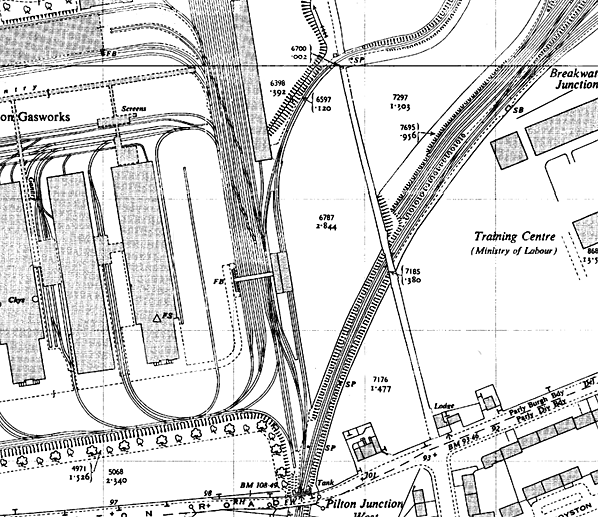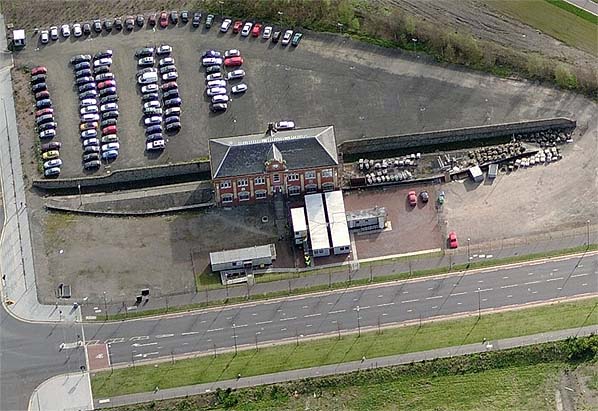Notes: By the 1890s, the Edinburgh Gas Works (New Street), Leith Gas Works (Baltic Street) and Portobello Gas Works (Pipe Street, Portobello) were operating at full capacity. The New Street and Portobello sites were hemmed in by other buildings and could not be expanded. At Leith it might have been possible to expand onto an adjacent site, but it was wisely concluded that a new works on a much larger site would permit future growth.
| Large quantities of coal were required for the production of gas and, in the days before efficient road transport, good rail access was essential. (By 1926 Granton Gas Works was consuming 200,000 tonnes of coal a year.) The existing Edinburgh and Leith works both had rail access, but only from the NBR and its rival, the Caledonian Railway. In addition, it was close |
 |
to the sea so that supplies could be brought by boat to Granton Harbour in the event of strikes on the railway. The Edinburgh & Leith Corporation Gas Commissioners thought of building their own small harbour at Granton, but this did not go ahead.
Following negotiation with the 6th Duke of Buccleuch, a 106¼ acre site at Granton was purchased for £124,000. Granton Gasworks was designed by Chief Engineer and Manager, Walter Ralph Herring. Production of coal gas started on 21 October 1902, although the works did not actually open until 27 February 1903. Until 1900 the site was in neither Edinburgh nor Leith, but in that year expansion of the city boundary brought it into Edinburgh. In 1920 Edinburgh and Leith amalgamated, and the gas undertaking passed to Edinburgh Corporation.
The main entrance was on West Granton Road, where offices were also constructed. To the north were buildings containing the coal store and, adjacent to that, the retort house where the actual gas production took place. To the east of the retort, from 1903 a private railway station was provided for workers. The service was run by the Caledonian Railway for the Edinburgh & Leith Corporation Gas Commissioners. The station building also contained the time office - where the workers were required to pass into and out of the works through turnstiles - as well as lavatories, bathrooms, and lockers for the men to store their outdoor clothing. From the upper floor a footbridge over the railway lines led to the works itself. In the early days workers were able to travel free of charge from Princes Street. Although passenger use of the station was restricted, and it was not included in public timetables, it was nevertheless shown as an open station on One-inch Ordnance Survey maps, as seen on the extract below.
 |
The station building is a plain Edwardian classical design, but with a red brick Baroque pediment and contrasting yellow brick and sandstone ashlar dressings. It has bays divided on all sides by giant yellow brick pilasters with fluted ashlar capitals, and slightly projecting red brick pedestals with ashlar coping; a red brick entablature is provided above with an ashlar architrave and eaves cornice. Yellow brick basket arches frame the ground floor windows, and there are stone sills throughout. The interior contains a |
wide flight of stone steps leading down to the ground floor from a slightly higher entrance. A narrower curved stone staircase adjoins to the north of the main entrance; this was the route taken by workers at the gasworks after leaving the train. The Gas Works had a network of standard gauge lines, connected to the main line network just north of the bridge which carried West Granton Road over the railway. The main line was part of the Caledonian Railway’s Granton Branch. Coal deliveries could therefore be taken into the works conveniently, and coke and other products sent away.
 |
In addition to the standard gauge lines, the works also had an internal system of narrow (2ft gauge) lines used by steam locomotives. The narrow gauge railway dealt with the ashes from the production process and with other waste and by-products. The locomotives were low in height and had no cabs, and were therefore able to pass under the gas retorts. This network closed in 1965.
Manufacture of gas at Granton came to an end in 1987. The gasholders continued in use for storage for a few more years: Gasholder No. 1, although the oldest, remained in use longest – until 2001.
As part of the major redevelopment of the Edinburgh waterfront the station building was chosen to remain standing as a reminder of the area’s industrial heritage and as a physical representation of the historic link between the city centre and the local area. The Category B listed building still displays the corporate seals, and the clock has been restored. Various other uses for the building are currently being considered. Two of the gasometers, built in the 1930s and 1970s, have been demolished. The third and oldest structure remains and is also listed as an example of Victorian industrial architecture.
Route map drawn by Alan Young tickets from Michael Stewart
Source: Our Transport Heritage web site, Granton History web site, EdinPhoto web site. |

gasworks_old6.jpg)


gasworks_old2.jpg)
gasworks_old9.jpg)
gasworks_old5.jpg)
gasworks_old3.jpg)
gasworks_old4.jpg)
gasworks_old8.jpg)
gasworks3.jpg)
gasworks1.jpg)




gasworks_old_thumb7.jpg)
gasworks_thumb4.jpg)
gasworks_thumb5.jpg)
gasworks_thumb2.jpg)

 Home Page
Home Page